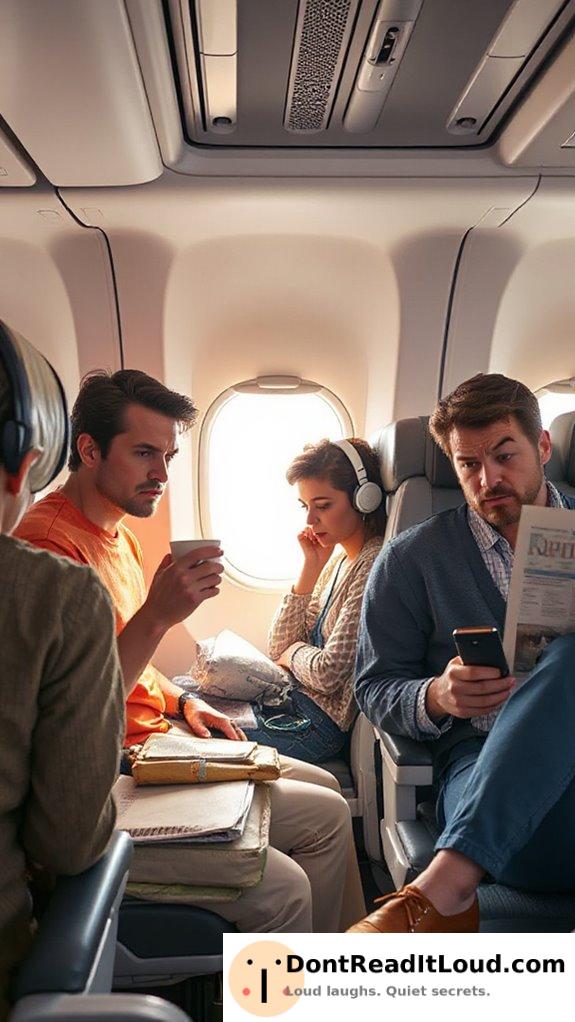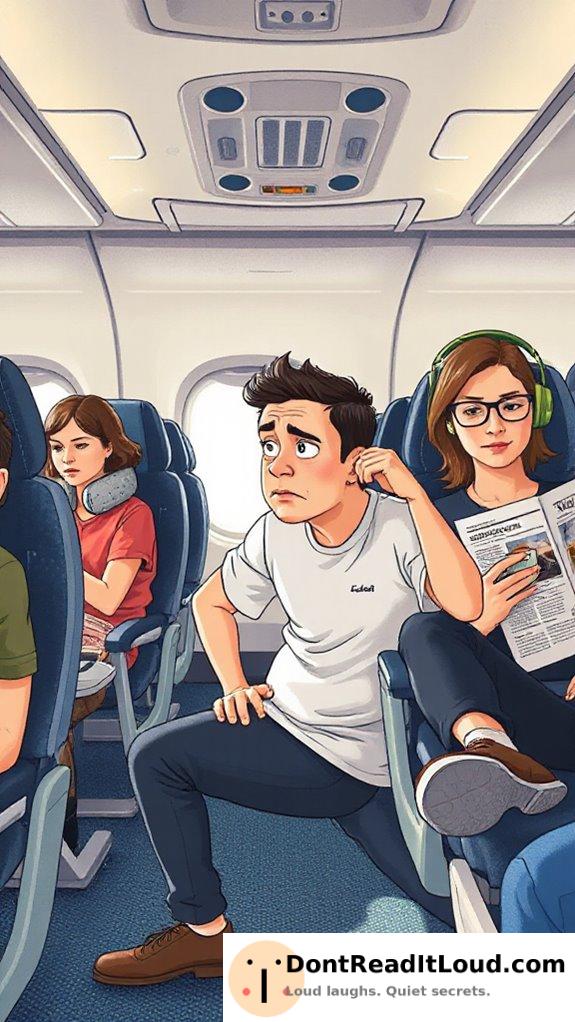
During flights, gas can build up since cabin pressure is lower, causing it to expand—so feeling gassy is common. Choose an aisle seat near the back for easier restroom access or discreet releases, and time them with engine noise or announcements for extra cover. Adjusting your posture can also help you stay subtle. Carry a small odor neutralizer, and try to avoid gassy foods before your flight. If you want to handle this tricky situation completely, there are even more tips to explore.
Understanding Why Gas Builds Up During Flights

When you fly, changes in cabin pressure can cause the gas in your digestive system to expand, making you feel bloated and gassy.
Airplane cabins are pressurized, but not to sea level—you’re actually sitting in an environment that feels like a high mountain.
Because of these pressure changes, any gas trapped in your gut will expand. The air inside your stomach and intestines takes up more space, putting extra pressure on your insides and making you feel the urge to fart.
Even if you don’t eat or drink more than usual, you’ll notice the effect.
Knowing this helps you understand that feeling gassy on a flight is normal—pressure changes and gas expansion are to blame.
Choosing the Best Seat for Maximum Discretion

Feeling gassy at 30,000 feet is almost inevitable, but you can control where you sit to make things less awkward.
When booking your flight, consider your seat choice carefully. An aisle seat gives you quick access to the restroom, making it easier to slip away if needed. You’ll also have fewer people blocking your path, which can help minimize embarrassment.
A window seat offers a bit more privacy and lets you turn away from others, but you might feel trapped if the row is full. For the most discretion, pick an aisle seat near the back of the plane. There’s less foot traffic, and the airflow helps clear any lingering odors.
Timing Your Release With Cabin Noise

Since airplanes are filled with a constant hum—from engines to air vents—you can use these background noises to your advantage.
Pay attention to how the sounds change around you. Sync your release with the loudest moments for the best cover. For example, wait for the engine’s roar during takeoff or when the landing gear is being pulled in.
Even routine announcements or the noise of drink carts can help hide your actions. Listen for times when conversations get louder, movies are playing, or turbulence shakes the cabin.
There’s no need to hurry—patience helps you stay discreet. Matching your timing to these natural sounds makes you less likely to be noticed.
Well-timed releases blend into the cabin’s background, keeping your secret safe.
Mastering Subtle Body Movements

To avoid drawing attention, master subtle body movements that minimize both noise and suspicion. Adjust your posture by slightly shifting your weight or raising one side of your body. This eases pressure, making any release quieter.
Watch your body language—don’t make abrupt or exaggerated moves that could alert those nearby. Instead, blend discreet adjustments with natural actions like reaching for your bag, stretching, or adjusting your seatbelt.
Time your movements with normal cabin activity. For example, lean forward as if searching for something, or shift when others in your row move.
Keep your expression relaxed, since nervous or guilty looks can attract unwanted attention. With practice, your actions will appear routine and go unnoticed.
Neutralizing Odors on the Go

Even with careful planning, odors can sometimes escape. That’s why it’s helpful to bring odor neutralizers. Pocket-sized sprays or discreet wipes work quickly and efficiently.
If you notice a smell, use your product subtly and promptly. Choose neutralizers that eliminate odors, rather than just cover them up. Avoid strong fragrances, as they can also attract attention.
Travel-sized fabric sprays can be useful air fresheners, but use them with restraint. A single spritz on clothing or the seat is usually sufficient.
If you’re near a lavatory, discreetly spray inside to take advantage of the airflow. Planning ahead helps reduce embarrassment and keeps fellow passengers comfortable.
What to Eat and Avoid Before Your Flight

Managing odors during a flight starts with your food choices well before you board.
Selecting the right pre-flight meal can make your journey more comfortable for everyone. Avoid foods that cause gas, such as beans, broccoli, cabbage, onions, and carbonated drinks, since these often lead to bloating and discomfort.
Instead, opt for lighter, easy-to-digest foods like bananas, rice, lean chicken, or yogurt. Drink water rather than soda to stay hydrated. Eating smaller portions will also help your stomach stay calm.
Thoughtful meal planning can minimize the risk of unwanted gas and help you travel more comfortably.
Conclusion
Flying can make anyone gassy, but a few clever strategies can help you stay discreet. Choose your seat carefully, time your release with ambient noise, shift position naturally, and watch what you eat to avoid suspicion. Air travel can be uncomfortable, but gas is a common issue. Use these tips to manage the situation smoothly and keep your dignity (and your neighbors’ comfort) intact.



